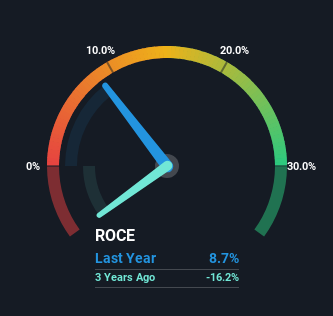Stock Analysis
- United Kingdom
- /
- Aerospace & Defense
- /
- LSE:RR.
There's Been No Shortage Of Growth Recently For Rolls-Royce Holdings' (LON:RR.) Returns On Capital

If we want to find a potential multi-bagger, often there are underlying trends that can provide clues. Firstly, we'd want to identify a growing return on capital employed (ROCE) and then alongside that, an ever-increasing base of capital employed. Put simply, these types of businesses are compounding machines, meaning they are continually reinvesting their earnings at ever-higher rates of return. So when we looked at Rolls-Royce Holdings (LON:RR.) and its trend of ROCE, we really liked what we saw.
Return On Capital Employed (ROCE): What Is It?
If you haven't worked with ROCE before, it measures the 'return' (pre-tax profit) a company generates from capital employed in its business. Analysts use this formula to calculate it for Rolls-Royce Holdings:
Return on Capital Employed = Earnings Before Interest and Tax (EBIT) ÷ (Total Assets - Current Liabilities)
0.087 = UK£1.3b ÷ (UK£30b - UK£15b) (Based on the trailing twelve months to June 2023).
So, Rolls-Royce Holdings has an ROCE of 8.7%. Ultimately, that's a low return and it under-performs the Aerospace & Defense industry average of 13%.
See our latest analysis for Rolls-Royce Holdings

Above you can see how the current ROCE for Rolls-Royce Holdings compares to its prior returns on capital, but there's only so much you can tell from the past. If you'd like to see what analysts are forecasting going forward, you should check out our free report for Rolls-Royce Holdings.
What Can We Tell From Rolls-Royce Holdings' ROCE Trend?
Rolls-Royce Holdings has broken into the black (profitability) and we're sure it's a sight for sore eyes. While the business was unprofitable in the past, it's now turned things around and is earning 8.7% on its capital. While returns have increased, the amount of capital employed by Rolls-Royce Holdings has remained flat over the period. With no noticeable increase in capital employed, it's worth knowing what the company plans on doing going forward in regards to reinvesting and growing the business. So if you're looking for high growth, you'll want to see a business's capital employed also increasing.
On a separate but related note, it's important to know that Rolls-Royce Holdings has a current liabilities to total assets ratio of 50%, which we'd consider pretty high. This can bring about some risks because the company is basically operating with a rather large reliance on its suppliers or other sorts of short-term creditors. While it's not necessarily a bad thing, it can be beneficial if this ratio is lower.
What We Can Learn From Rolls-Royce Holdings' ROCE
In summary, we're delighted to see that Rolls-Royce Holdings has been able to increase efficiencies and earn higher rates of return on the same amount of capital. And given the stock has remained rather flat over the last five years, there might be an opportunity here if other metrics are strong. With that in mind, we believe the promising trends warrant this stock for further investigation.
One more thing: We've identified 2 warning signs with Rolls-Royce Holdings (at least 1 which makes us a bit uncomfortable) , and understanding them would certainly be useful.
For those who like to invest in solid companies, check out this free list of companies with solid balance sheets and high returns on equity.
Valuation is complex, but we're helping make it simple.
Find out whether Rolls-Royce Holdings is potentially over or undervalued by checking out our comprehensive analysis, which includes fair value estimates, risks and warnings, dividends, insider transactions and financial health.
View the Free AnalysisHave feedback on this article? Concerned about the content? Get in touch with us directly. Alternatively, email editorial-team (at) simplywallst.com.
This article by Simply Wall St is general in nature. We provide commentary based on historical data and analyst forecasts only using an unbiased methodology and our articles are not intended to be financial advice. It does not constitute a recommendation to buy or sell any stock, and does not take account of your objectives, or your financial situation. We aim to bring you long-term focused analysis driven by fundamental data. Note that our analysis may not factor in the latest price-sensitive company announcements or qualitative material. Simply Wall St has no position in any stocks mentioned.
About LSE:RR.
Rolls-Royce Holdings
Rolls-Royce Holdings plc develops and delivers complex power and propulsion solutions for air, sea, and land in the United Kingdom and internationally.
Undervalued with questionable track record.

